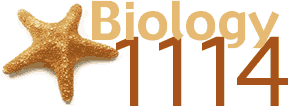Return
to Biology 1114 Index Page

Guiding Principles for Effective Learning
Thomas
Angelo's "teacher's dozen" represent a list of fourteen principles
of "effective higher learning" that are well supported by research.
Angelo's objective in developing these principles is to help faculty improve
the quality of higher learning in their classrooms
- Active
learning is more effective than passive learning.
- Learning
requires focused attention, and awareness of the importance of what is to
be learned.
-
Learning is more effective and efficient when learners have explicit, reasonable,
positive goals, and when their goals fit well with the teacher's goals.
-
To be remembered, new information must be meaningfully connected to prior
knowledge and it must be remembered in order to be learned.
-
Unlearning what is already learned is often more difficult than learning new
information.
-
Information organized in personally meaningful ways is more likely to be retained,
learned, and used.
-
Learners need feedback on their learning, early and often, to learn well;
to become independent, they need to learn how and give themselves feedback.
-
The ways in which learners are assessed and evaluated powerfully affect the
ways they study and learn.
-
Mastering a skill or body of knowledge takes great amounts of time and effort.
-
Learning to transfer, to apply previous knowledge and skills to new contexts,
requires a great deal of practice.
-
High expectations encourage high achievement.
-
To be more effective, teachers need to balance levels of intellectual challenge
and instructional support.
-
Motivation to learn is alterable; it can be positively or negatively affected
by the task, the environment, the teacher, and the learner.
-
Interaction between teachers and learners is one of the most powerful factors
in promoting learning, interaction among learners is another.
[Angelo,
T. 1993 A "Teacher's Dozen": Fourteen general research-based principles
for improving higher learning in our classrooms. AAHE Bulletin. April 1993:
3-13].

